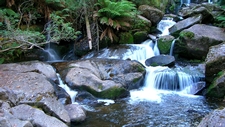Bodies of Water

TEKS Objective
The student is expected to identify and describe a variety of natural sources of water, including streams, lakes, and oceans.
Essential Understanding
The student knows that the natural world includes rocks, soil, and water that can be observed in cycles, patterns, and systems.
Science Background
Water Resources: US Geological Survey (website) - Interactive information about the nation's water resources, including water data, publications and maps.
Water Resources
US Geological Survey, www.usgs.gov
Water Basics: US Geological Survey (website) - Information about water, including sources such as rivers, lakes and groundwater.
Water Basics
US Geological Survey, Water Resources of Georgia, water.usgs.gov/edu
Earth’s Ocean: Windows to the Universe (website) – Earth’s ocean covers more than 70% of its surface. Find out more about ocean water here.
Earth’s Ocean
Windows to the Universe, www.windows2universe.org
Signature Lesson
River Ecology: BioEd Online (Website) - Students identify and describe natural water sources, and simulate human activities that can affect a water source, such as a river flowing through a community.
- Supporting Lessons
- Extensions
- Assessment Ideas
- Literature Connections
- Related
TEKS - Additional Resources
Supporting Lessons
Discoveries at Willow Creek: The Globe Program (website) - Follow Simon, Anita and Dennis as they join Hannah, a local scientist, in making new water-related discoveries at Willow Creek. This module contains a storybook and learning activities.
Discoveries at Willow Creek
The Globe Program, globe.gov
Splish, Splash: Water’s Journey to My Glass: National Geographic (website) – Students learn to identify and describe natural sources of water, and use a map to trace the sources of water in their community.
Splish, Splash: Water’s Journey to My Glass
National Geographic, www.nationalgeographic.com
Use information from USGS to find a map of your local watershed to use with this lesson.
Elaboration Lessons and Extensions
Under the Deep Blue Sea: National Endowment for the Humanities (website) - After locating Earth's major oceans on a world map, students “dive underwater” to explore oceans and the plants and animals that live in the sea.
Under the Deep Blue Sea
National Endowment for the Humanities, ed2.neh.gov
Rivers and Streams: Missouri Botanical Gardens (website) - Information about the vast web of rivers and streams channeling water across the planet.
Rivers and Streams
Missouri Botanical Gardens, www.mbgnet.net
Assessment Ideas
Assess students’ understanding of natural water sources by collecting pictures of streams, lakes, oceans, water wells, rivers, ponds, etc. Have each student work with a partner to identify and describe the various sources of water.
Literature Connections
Sources of Water. Olien, Rebecca (ISBN: 0736851801)
Lakes. Berne, Emma Carlson (ISBN: 1404242082)
Learning about the Earth: Ponds. Sexton, Colleen (ISBN: 1600142303)
Additional Resources
Three States of Water: K8 Science (video) - In the water cycle, individual water molecules travel as liquid water in the ocean, water vapor in the atmosphere, and liquid water and ice on land and underground. Learn more about the properties of water as you watch this video.
Three States of Water
K8 Science, www.k8science.org
Create a Lasting Water Cycle: BioEd Online (Website) - Students learn that water can be found naturally as a solid, a liquid or a gas, and that it circulates among these three states in the water cycle.
Create a Lasting Water Cycle
BioEd Online, www.bioedonline.org
Earth: More Land or More Water? Education.com (website) - Blend science and math to explore a very important first grade social studies question: Does our planet contain more land or more water?
Earth: More Land or More Water?
by Julie Williams, www.education.com
TEKS Navigation
Grade 1
Need Assistance?
If you need help or have a question please use the links below to help resolve your problem.

Comments